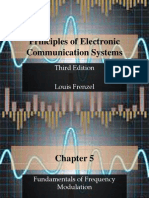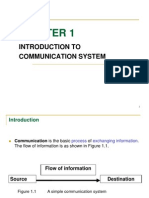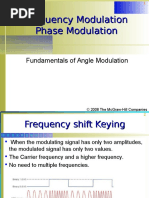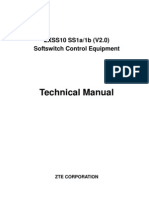Module 4 (Frequency Modulation)
Uploaded by
Sarah J SinfuegoModule 4 (Frequency Modulation)
Uploaded by
Sarah J SinfuegoECE 311 – FUNDAMENTALS OF ELECTRONIC COMMUNICATIONS
MODULE - 4
MODULE TITLE: FREQUENCY MODULATION FUNDAMENTALS
Textbook: Principles of Electronics Communications by Louis Frenzel Jr.
LEARNING OBJECTIVES:
After finishing this module, you are expected to:
1. Compare and contrast frequency modulation and phase modulation.
2. Calculate the modulation index given the maximum deviation and the
maximum modulating frequency and use the modulation index and Bessel
coefficients to determine the number of significant sidebands in an FM signal.
3. Calculate the bandwidth of an FM signal by using two methods and explain
the difference between the two.
4. Explain how pre-emphasis is used to solve the problem of the interference of
high-frequency components by noise.
5. List the advantages and disadvantages of FM as compared to AM.
6. Give the reasons for FM’s superior immunity to noise.
TOPICS:
1. Basic Principles of Frequency Modulation
2. Principles of Phase Modulation
3. Modulation Index and Sidebands
4. Noise Suppression Effects of FM
5. Frequency Modulation Versus Amplitude modulation
INTRODUCTION:
Impressing an information signal on a carrier by changing its frequency produces
FM. Varying the amount of phase shift that a carrier experiences is known as phase
modulation (PM). Varying the phase shift of a carrier also produces FM. FM and PM are
collectively referred to as angle modulation. Since FM is generally superior in
performance to AM, it is widely used in many areas of communication electronics.
Engr. Vincent E. Malapo
Instructor 1
ECE 311 – FUNDAMENTALS OF ELECTRONIC COMMUNICATIONS
LESSON PROPER:
4.1 Basic Principles of Frequency Modulation
In FM, the carrier amplitude remains constant and the carrier frequency is
changed by the modulating signal.
As the modulating signal amplitude increases, the carrier frequency increases. If
the amplitude of the modulating signal decreases, the carrier frequency
decreases.
The reverse relationship can also be implemented. A decreasing modulating
signal increases the carrier frequency above its center value, whereas an
increasing modulating signal decreases the carrier frequency below its center
value.
The carrier frequency varies above and below its normal center, or resting,
frequency with no modulation.
The amount of change in carrier frequency produced by the modulating signal is
known as the frequency deviation (fd).
The frequency of the modulating signal determines the frequency deviation rate,
or how many times per second the carrier frequency deviates above and below
its center frequency.
Assume a carrier frequency of 150 MHz. If the peak amplitude of the modulating
signal causes a maximum frequency shift of 30 kHz, the carrier frequency will
deviate up to 150.03 MHz and down to 149.97 MHz. The total frequency
deviation is 150.03 − 149.97 = 0.06 MHz = 60 kHz.
In practice, however, the frequency deviation is expressed as the amount of
frequency shift of the carrier above or below the center frequency. Thus, the
frequency deviation for the 150-MHz carrier frequency is represented as ±30
kHz. This means that the modulating signal varies the carrier above and below its
center frequency by 30 kHz.
Note that the frequency of the modulating signal has no effect on the amount of
deviation, which is strictly a function of the amplitude of the modulating signal.
Example 4.1
Engr. Vincent E. Malapo
Instructor 1
ECE 311 – FUNDAMENTALS OF ELECTRONIC COMMUNICATIONS
Figure 4.1
Engr. Vincent E. Malapo
Instructor 1
ECE 311 – FUNDAMENTALS OF ELECTRONIC COMMUNICATIONS
When the modulating signal is a pulse train or a series of rectangular waves,
e.g. a serial binary data, which only has two amplitudes, the output frequency
modulated signal has only two values. This kind of modulation, called
frequency-shift keying (FSK), is widely used in the transmission of binary
data in Bluetooth headsets, wireless speakers, and many forms of industrial
wireless.
Figure 4.2
4.2 Principles of Phase Modulation
Phase Modulation results when the amount of phase shift of a constant-
frequency carrier is varied in accordance with a modulating signal.
If a constant-amplitude, constant-frequency carrier sine wave is applied to the
phase shifter whose phase shift is varied by the intelligence signal, the output
of the phase shifter is a PM wave.
As the modulating signal goes positive, the amount of phase lag, and thus the
delay of the carrier output, increases with the amplitude of the modulating
signal. The result at the output is the same as if the constant-frequency carrier
signal had been stretched out, or had its frequency lowered.
When the modulating signal goes negative, the phase shift becomes leading.
This causes the carrier sine wave to be effectively speeded up, or
compressed. The result is the same as if the carrier frequency had been
increased. The result is the same as if the carrier frequency had been
increased.
Note that it is the dynamic nature of the modulating signal that causes the
frequency variation at the output of the phase shifter: FM is produced only as
long as the phase shift is varying.
Engr. Vincent E. Malapo
Instructor 1
ECE 311 – FUNDAMENTALS OF ELECTRONIC COMMUNICATIONS
Figure 4.3
The modulating signal shown in Fig. 4.3(a), which is a triangular wave whose
positive and negative peaks have been clipped off at a fixed amplitude.
Applying this modulating signal to a frequency modulator produces the FM signal
shown in Fig. 4.3(b). During the time the waveform is rising (t1), the frequency
increases. During the time the positive amplitude is constant (t2), the FM output
frequency is constant. During the time the amplitude decreases and goes
negative (t3), the frequency decreases. During the constant-amplitude negative
alternation (t4), the frequency remains constant, at a lower frequency. During t5,
the frequency increases.
Engr. Vincent E. Malapo
Instructor 1
ECE 311 – FUNDAMENTALS OF ELECTRONIC COMMUNICATIONS
During increases or decreases in amplitude (t1, t3, and t5), a varying frequency
is produced. However, during the constant-amplitude positive and negative
peaks, no frequency change takes place.
The output of the phase modulator is simply the carrier frequency that has been
shifted in phase.
The maximum frequency deviation produced by a phase modulator occurs during
the time when the modulating signal is changing at its most rapid rate.
For a sine wave modulating signal, the rate of change of the modulating signal is
greatest when the modulating wave changes from plus to minus or from minus to
plus.
Note that in an FM wave the maximum deviation occurs at the peak positive and
negative amplitude of the modulating voltage. In PM, although a phase modulator
does indeed produce FM, maximum deviation occurs at different points of the
modulating signal.
In PM, the amount of carrier deviation is proportional to the rate of change of the
modulating signal, i.e., the calculus derivative.
Phases-Shift Keying (PSK) or Binary Phase Shift Keying (BPSK) results from
the modulation, using a phase shifter, of a carrier signal by binary signals. Each
time the signal changes from 0 to 1 or 1 to 0, there is a 180° phase shift.
Figure 4.4
4.3 Modulation Index and Sidebands
Any modulation process produces sidebands.
In FM and PM, a large number of pairs of upper and lower sidebands are
generated.
The spectrum of an FM or a PM signal is usually wider than that of an
equivalent AM signal. But it is also possible to generate a special narrowband
FM signal whose bandwidth is only slightly wider than that of an AM signal.
Figure 4.5 shows the frequency spectrum of a typical FM signal produced by
modulating a carrier with a single-frequency sine wave. Note that the
sidebands are spaced from the carrier fc and from one another by a frequency
equal to the modulating frequency fm.
Engr. Vincent E. Malapo
Instructor 1
ECE 311 – FUNDAMENTALS OF ELECTRONIC COMMUNICATIONS
Figure 4.5
As the amplitude of the modulating signal varies, the frequency deviation
changes.
The number of sidebands produced, and their amplitude and spacing, depends
on the frequency deviation and modulating frequency.
FM process produces an infinite number of upper and lower sidebands but only
those sidebands with the largest amplitudes are significant in carrying the
information.
Modulation Index
The ratio of the frequency deviation to the modulating frequency is known as the
modulation index mf:
where fd is the frequency deviation and fm is the modulating frequency.
When the maximum allowable frequency deviation and the maximum modulating
frequency are used in computing the modulation index, mf is known as the
deviation ratio.
Engr. Vincent E. Malapo
Instructor 1
ECE 311 – FUNDAMENTALS OF ELECTRONIC COMMUNICATIONS
Example 4.2
Sidebands
The sidebands of an FM signal is dependent upon the value of the modulation
index. The corresponding number of sidebands is obtained using the Bessel
Table below.
Table 4.1
Figure 4.6 Table 4.1
Engr. Vincent E. Malapo
Instructor 1
ECE 311 – FUNDAMENTALS OF ELECTRONIC COMMUNICATIONS
Example 4.3
Figure 4.7
Engr. Vincent E. Malapo
Instructor 1
ECE 311 – FUNDAMENTALS OF ELECTRONIC COMMUNICATIONS
FM Signal Bandwidth
The total bandwidth of an FM signal can be determined by knowing the
modulation index and using Bessel table with the simple formula
=2
where fm is the modulating frequency and N is the number of significant
sidebands in the signal.
Another way to determine the bandwidth of an FM signal is to use Carson’s rule
given by:
=2 ( ) − ( )
Carson’s rule will always give a bandwidth lower than that calculated with the
formula BW = 2fmN. However, it has been proven that if a circuit or system has
the band-width calculated by Carson’s rule, the sidebands will indeed be passed
well enough to ensure full intelligibility of the signal.
Example 4.3
4.4 Noise Suppression Effects of FM
Noise is interference generated by lightning, motors, automotive ignition systems,
and any power line switching that produces transient signals.
Such noise is typically narrow spikes of voltage with very high frequencies. They
add to a signal and interfere with it. If the noise signals were strong enough, they
could completely obliterate the information signal.
Engr. Vincent E. Malapo
Instructor 1
ECE 311 – FUNDAMENTALS OF ELECTRONIC COMMUNICATIONS
FM signals have a constant modulated carrier amplitude, and FM receivers
contain limiter circuits that deliberately restrict the amplitude of the received
signal.
Figure 4.8
Noise spikes does not affect the information content of the FM signal, since it is
contained solely within the frequency variations of the carrier.
Noise and Phase Shift
The noise amplitude added to an FM signal introduces a small frequency
variation, or phase shift, which changes or distorts the signal.
Figure 4.9
From the figure, the carrier signal is represented by a fixed-length (amplitude)
phasor S.
Engr. Vincent E. Malapo
Instructor 1
ECE 311 – FUNDAMENTALS OF ELECTRONIC COMMUNICATIONS
Assume a single high-frequency noise signal varying in phase represented as a
rotating phasor N. The composite signal of the carrier and the noise, labeled C, is
a phasor whose amplitude is the phasor sum of the signal and noise and a phase
angle shifted from the carrier by an amount ϕ. This angle can be computed using
the formula
To determine just how much of a frequency shift a particular phase shift
produces, we use the formula
Example 4.4
4.5 Frequency Modulation Versus Amplitude Modulation
In general, FM is considered to be superior to AM. Although both AM and FM
signals can be used to transmit information from one place to another, FM typically
offers some significant benefits over AM.
Advantages of FM
Noise Immunity. The main benefit of FM over AM is its superior immunity to
noise, made possible by the clipper limiter circuits in the receiver, which
effectively strip off all the noise variations, leaving a constant-amplitude FM
signal. Although clipping does not result in total recovery in all cases, FM can
Engr. Vincent E. Malapo
Instructor 1
ECE 311 – FUNDAMENTALS OF ELECTRONIC COMMUNICATIONS
nevertheless tolerate a much higher noise level than AM for a given carrier
amplitude.
Capture Effect. Another major benefit of FM is that interfering signals on the
same frequency are effectively rejected. Because of the amplitude limiters and
the demodulating methods used by FM receivers, a phenomenon known as the
capture effect takes place when two or more FM signals occur simultaneously on
the same frequency.
Transmitter Efficiency. FM signals have a constant amplitude, and it is
therefore not necessary to use linear amplifiers to increase their power level. In
fact, FM signals are always generated at a lower level and then amplified by a
series of class C amplifiers to increase their power. The result is greater use of
available power because of the high level of efficiency of class C amplifiers.
Disadvantages of FM
Excessive Spectrum Use. Perhaps the greatest disadvantage of FM is that it
simply uses too much spectrum space. The bandwidth of an FM signal is, in
general, considerably wider than that of an AM signal transmitting similar
information.
Circuit Complexity. One major disadvantage of FM in the past involved the
complexity of the circuits used for frequency modulation and demodulation in
comparison with the simple circuits used for amplitude modulation and
demodulation. Today, this disadvantage has almost disappeared because of the
use of integrated circuits.
Engr. Vincent E. Malapo
Instructor 1
ECE 311 – FUNDAMENTALS OF ELECTRONIC COMMUNICATIONS
ASSESSMENT TASK:
Questions:
1. State how the frequency of a carrier varies in an FM system when the modulating
signal amplitude and frequency change.
2. State how the frequency of a carrier varies in a PM system when the modulating
signal amplitude and frequency change.
3. When does maximum frequency deviation occur in an FM signal? A PM signal?
4. Discuss Frequency Shift Keying and Phase Shift Keying/Binary Phase Shift
Keying.
5. What is the difference between the modulation index and the deviation ratio?
6. Discuss two ways that noise affects an FM signal.
Problems:
1. A 162-MHz carrier is deviated by 12 kHz by a 2-kHz modulating signal. What is
the modulation index?
2. The maximum deviation of an FM carrier with a 2.5-kHz signal is 4 kHz. What is
the deviation ratio?
3. For Problems 1 and 2, compute the bandwidth occu-pied by the signal, by using
the conventional method and Carson’s rule. Sketch the spectrum of each signal,
showing all significant sidebands and their exact amplitudes.
4. For a single-frequency sine wave modulating signal of 3 kHz with a carrier
frequency of 36 MHz, what is the spacing between sidebands?
5. The signal-to-noise ratio in an FM system is 4:1. The maximum allowed deviation
is 4 kHz. How much frequency deviation is introduced by the phase shift caused
by the noise when the modulating frequency is 650 Hz? What is the real signal-
to-noise ratio?
Engr. Vincent E. Malapo
Instructor 1
You might also like
- A Nonmathematical Approach To Radar: How A Phasor Represents A SignalNo ratings yetA Nonmathematical Approach To Radar: How A Phasor Represents A Signal13 pages
- Princom Fundamentals of Frequency ModulationNo ratings yetPrincom Fundamentals of Frequency Modulation5 pages
- ECE 314B Principles of Communication Systems WK10to13 ModuleNo ratings yetECE 314B Principles of Communication Systems WK10to13 Module30 pages
- EE410-Communication Systems Fall 2020 OBE Course Outline-FINALNo ratings yetEE410-Communication Systems Fall 2020 OBE Course Outline-FINAL5 pages
- Value Based-Safety and Off-The-job SafetyNo ratings yetValue Based-Safety and Off-The-job Safety12 pages
- Chapter 1: Introduction To Electronic CommunicationsNo ratings yetChapter 1: Introduction To Electronic Communications33 pages
- Principle of Communications Module 1 PretestNo ratings yetPrinciple of Communications Module 1 Pretest4 pages
- Lesson 1 Introduction To Principles of CommunicationNo ratings yetLesson 1 Introduction To Principles of Communication74 pages
- Communication Electronic 2 Edition - Frenzel ©2008 Created by Kai Raimi - BHCNo ratings yetCommunication Electronic 2 Edition - Frenzel ©2008 Created by Kai Raimi - BHC24 pages
- Signal Processing and Filter Design Using Scilab0% (2)Signal Processing and Filter Design Using Scilab69 pages
- Signals, Spectra, Signal Processing ECE 401: Table ofNo ratings yetSignals, Spectra, Signal Processing ECE 401: Table of1 page
- Batangas State University College of Engineering, Architecture & Fine ArtsNo ratings yetBatangas State University College of Engineering, Architecture & Fine Arts9 pages
- Custom Integrated Circuit Design Using Open-Source ToolsNo ratings yetCustom Integrated Circuit Design Using Open-Source Tools1 page
- Principles of Electronic Communication Systems: Third EditionNo ratings yetPrinciples of Electronic Communication Systems: Third Edition38 pages
- 11.instructional Manual Sample Program OutputNo ratings yet11.instructional Manual Sample Program Output30 pages
- Signals and Systems For Signals and Systems ForNo ratings yetSignals and Systems For Signals and Systems For74 pages
- Wireless Module - Microwave PropagationNo ratings yetWireless Module - Microwave Propagation58 pages
- (Chapter 1) Introduction To Electronic Communication (1-18) PDFNo ratings yet(Chapter 1) Introduction To Electronic Communication (1-18) PDF18 pages
- ELX 122 MODULE 3 Modulation Techniques (FM)No ratings yetELX 122 MODULE 3 Modulation Techniques (FM)11 pages
- By Ihsan Ulhaq: Fundamentals of Frequency ModulationNo ratings yetBy Ihsan Ulhaq: Fundamentals of Frequency Modulation51 pages
- Elements of Telecommunication: Frequency ModulationNo ratings yetElements of Telecommunication: Frequency Modulation41 pages
- President Mckinley II Usa Owners ManualNo ratings yetPresident Mckinley II Usa Owners Manual72 pages
- RSA306B USB Real Time Spectrum Analyzer Datasheet 37W603759No ratings yetRSA306B USB Real Time Spectrum Analyzer Datasheet 37W60375926 pages
- Question Bank Subject Name & Code: Ge6252 - Basic Electrical & Electronics EnggNo ratings yetQuestion Bank Subject Name & Code: Ge6252 - Basic Electrical & Electronics Engg9 pages
- A Transformer-Based OFDM Receiver For Underwater Acoustic CommunicationNo ratings yetA Transformer-Based OFDM Receiver For Underwater Acoustic Communication5 pages
- Chap10 - Passband (Digital Modulation) PDFNo ratings yetChap10 - Passband (Digital Modulation) PDF44 pages
- 1b (V2.0) Softswitch Control Equipment Technical Manual0% (1)1b (V2.0) Softswitch Control Equipment Technical Manual96 pages
- Gaussian Minimum Shift Keying (GMSK) : Raafat Ali Supervisor: Dr. Nizar ZarkaNo ratings yetGaussian Minimum Shift Keying (GMSK) : Raafat Ali Supervisor: Dr. Nizar Zarka17 pages
- Experiment No. 02 Am Demodulation: Pre Lab Task Lab ObjectiveNo ratings yetExperiment No. 02 Am Demodulation: Pre Lab Task Lab Objective8 pages
- A Nonmathematical Approach To Radar: How A Phasor Represents A SignalA Nonmathematical Approach To Radar: How A Phasor Represents A Signal
- ECE 314B Principles of Communication Systems WK10to13 ModuleECE 314B Principles of Communication Systems WK10to13 Module
- EE410-Communication Systems Fall 2020 OBE Course Outline-FINALEE410-Communication Systems Fall 2020 OBE Course Outline-FINAL
- Chapter 1: Introduction To Electronic CommunicationsChapter 1: Introduction To Electronic Communications
- Lesson 1 Introduction To Principles of CommunicationLesson 1 Introduction To Principles of Communication
- Communication Electronic 2 Edition - Frenzel ©2008 Created by Kai Raimi - BHCCommunication Electronic 2 Edition - Frenzel ©2008 Created by Kai Raimi - BHC
- Signals, Spectra, Signal Processing ECE 401: Table ofSignals, Spectra, Signal Processing ECE 401: Table of
- Batangas State University College of Engineering, Architecture & Fine ArtsBatangas State University College of Engineering, Architecture & Fine Arts
- Custom Integrated Circuit Design Using Open-Source ToolsCustom Integrated Circuit Design Using Open-Source Tools
- Principles of Electronic Communication Systems: Third EditionPrinciples of Electronic Communication Systems: Third Edition
- (Chapter 1) Introduction To Electronic Communication (1-18) PDF(Chapter 1) Introduction To Electronic Communication (1-18) PDF
- Modulation and Coding Techniques in Wireless CommunicationsFrom EverandModulation and Coding Techniques in Wireless Communications
- By Ihsan Ulhaq: Fundamentals of Frequency ModulationBy Ihsan Ulhaq: Fundamentals of Frequency Modulation
- Elements of Telecommunication: Frequency ModulationElements of Telecommunication: Frequency Modulation
- RSA306B USB Real Time Spectrum Analyzer Datasheet 37W603759RSA306B USB Real Time Spectrum Analyzer Datasheet 37W603759
- Question Bank Subject Name & Code: Ge6252 - Basic Electrical & Electronics EnggQuestion Bank Subject Name & Code: Ge6252 - Basic Electrical & Electronics Engg
- A Transformer-Based OFDM Receiver For Underwater Acoustic CommunicationA Transformer-Based OFDM Receiver For Underwater Acoustic Communication
- 1b (V2.0) Softswitch Control Equipment Technical Manual1b (V2.0) Softswitch Control Equipment Technical Manual
- Gaussian Minimum Shift Keying (GMSK) : Raafat Ali Supervisor: Dr. Nizar ZarkaGaussian Minimum Shift Keying (GMSK) : Raafat Ali Supervisor: Dr. Nizar Zarka
- Experiment No. 02 Am Demodulation: Pre Lab Task Lab ObjectiveExperiment No. 02 Am Demodulation: Pre Lab Task Lab Objective






























































































